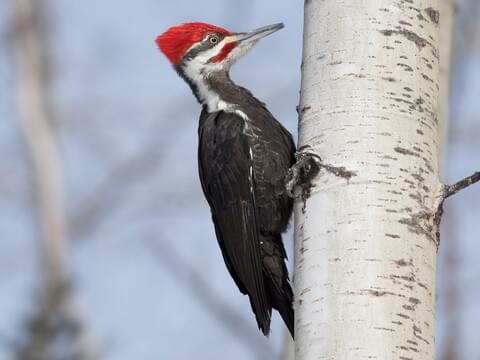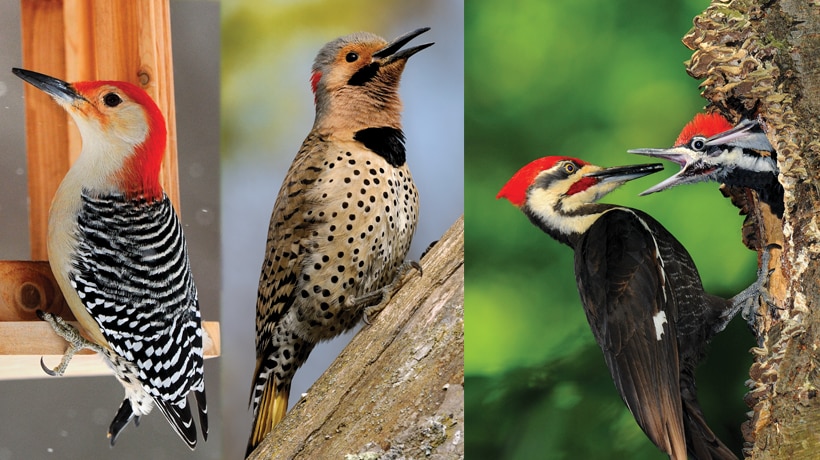Woodpeckers in Florida: Recognition Tips and Environment Preferences
Woodpeckers in Florida: Recognition Tips and Environment Preferences
Blog Article
Woodpeckers Unleashed: Checking Out the Marvels of These Skilled Tree Climbers
Woodpeckers, with their distinct markings and rhythmic drumming resembling with wooded locations, hold an unique place in the bird globe - Woodpeckers in Florida. As we dig right into the detailed information of woodpeckers' nesting practices, feeding techniques, and the ongoing preservation initiatives to secure these remarkable birds, a much deeper admiration for their location in nature unravels.
Anatomy and Adaptations
When analyzing the makeup and adaptations of woodpeckers, one can observe exceptional functions that make it possible for these birds to flourish in their specialized environmental particular niche. In addition, woodpeckers have zygodactyl feet, with 2 toes facing ahead and 2 dealing with in reverse, offering a company grip on tree trunks while they search for food or drum for communication.
In addition, woodpeckers have an unique tongue structure that is long, barbed, and sticky, allowing them to extract insects from crevices in timber. This specialized adaptation allows woodpeckers to exploit a food source that is hard to reach to lots of various other bird varieties. On the whole, the makeup and adjustments of woodpeckers showcase the impressive transformative remedies that have enabled these birds to flourish in their arboreal environment.
Drumming Habits
Having checked out the composition and adaptations of woodpeckers, the focus now moves to understanding their drumming behavior, a distinctive facet of their communication and territorial screens. Drumming is an essential kind of interaction among woodpeckers, serving multiple objectives such as establishing areas, bring in friends, and signaling alarm. Each woodpecker species has an one-of-a-kind drumming pattern that helps individuals identify participants of their very own species and identify them from competitors or predators.
Woodpeckers produce drumming audios by swiftly pecking on powerful surface areas such as dead trees, energy poles, or perhaps steel items, creating a collection of balanced beats. The intensity and speed of drumming can vary based on the function; as an example, a quick drumming series may represent aggressiveness towards burglars, while a slower and softer drumming pattern can show courtship (Woodpeckers in Florida). Furthermore, woodpeckers may adjust the frequency and duration of their drumming to share details messages efficiently
Nesting Practices
Checking out the nesting habits of woodpeckers discloses fascinating insights right into their reproductive actions and habitat choices. Woodpeckers are known for their distinct nesting preferences, frequently digging deep into tooth cavities in content trees to produce sheltered rooms for elevating their young. These dental caries offer not just as a nesting website yet likewise as a safe and secure sanctuary from predators and inclement climate.
Woodpeckers display a high degree of integrity to their nesting websites, usually going back to the very same place every year. This habits highlights the relevance of suitable habitat accessibility for their reproductive success. The option of a nesting website is crucial for woodpeckers, with factors such as tree types, elevation, and degeneration phase playing substantial duties in their decision-making process.
Remarkably, some woodpecker varieties are known to excavate numerous dental caries within their territory, providing themselves with alternative nesting choices. This technique might offer as a form of insurance versus prospective dangers or disruptions to their primary nesting site.

Feeding Techniques
Woodpeckers employ a range of specialized feeding methods to acquire their primary food sources. One of one of the most distinctive feeding actions of woodpeckers is drumming, which involves quick pecking on trees to discover insects underneath the bark. This drumming not only helps them locate victim but also acts as a means of interaction with various other woodpeckers. Woodpeckers have solid, chisel-like beaks that permit them to drill into timber effortlessly. Once an opening is produced, they use their long, barbed tongues to remove pests such as ants, beetles, larvae, and spiders. These tongues are covered with sticky saliva that assists trap the victim. Woodpeckers are additionally known to dig deep into dental caries in trees to gain access to hidden insect larvae or sap. Some species, like the acorn woodpecker, store nuts in specifically developed holes called granaries. This calculated storing of food aids them endure throughout food scarcity durations. Woodpeckers are absolutely amazing in their feeding techniques, showcasing versatility and intelligence in procuring their nourishment.
Conservation Initiatives
In the middle of the complex feeding techniques displayed by read this post here woodpeckers, the preservation efforts targeted at guarding these interesting birds play an important role in protecting their environments and populaces. Woodpeckers face various threats to their survival, including environment loss as a result of deforestation, climate modification modifying their environments, and collisions with synthetic structures such as buildings and automobiles - Woodpeckers in Florida. Guardians are actively functioning to resolve these difficulties and ensure the lasting well-being of woodpecker types

Education and learning and public recognition campaigns are likewise important components of woodpecker conservation initiatives. By raising understanding concerning the significance of these birds in preserving healthy and balanced forest environments, preservationists can amass support for environment conservation initiatives and advertise accountable land administration methods. Via collective initiatives in between scientists, policymakers, and regional communities, we can collaborate to safeguard a future where woodpeckers flourish in their natural environments.
Final Thought

Report this page